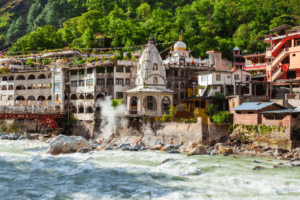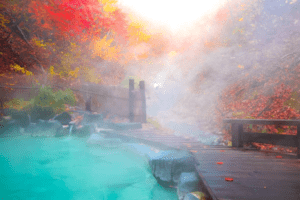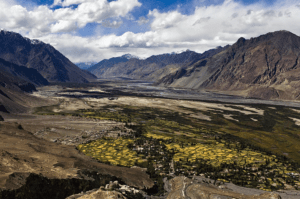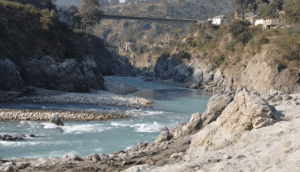HIMALAYAN HOT SPRINGS to add to your bucket list
One assumes Himalayas is synonymous to cold and snow.
But Mother Earth has lots of surprises in store, even up there in the higher terrains! While she is revealing them one by one, let’s look at one special and amazing surprise – Hot Springs!
A hot spring is produced when exothermally heated ground water rises from the earth crust. Hot springs are a balm for stressed nerves and people soak in them as a natural spa. However, only some are safe for the body while others are scalding and can cause injuries.
The ones we are about to discuss below are just right for your welfare, and they lie in different setting right in the cold, very cold and snowy Himalayas!
Now, image yourself indulging in the Himalayan natural spa with scenic and snowy views all around. Pretty picture isn’t it?
There are about 70 hot springs in Uttarkhand and 30 in Himachal according to study by Wadia Institute of Himalayan Geology. Many of them are out of bounds but the following are worth visiting…
There arises a hot spring from the earth core in this area and that has several minerals including sulphur and uranium which are said to cure skin diseases.
According to Hindu scriptures, Manu the first human initiated life here and saved this area from massive floods. You will discover more mythological tales Lord Shiva, Goddess Parvati and Lord Vishnu from the locals up on this trek.
This place is also sacred for the followers of Sikh religion. The Sikh Guru, Guru Nanak is said to have come to this place with his disciples during the third Udasi. While the locals gave them grains, cooking became an issue due to the cold climate prevalent.
Guru Nanak asked his disciple Bhai Mardana to lift a particular stone in the area. When this was done a hot spring rose and helped in cooking food for the whole travelling group. A Gurudwara was constructed here to highlight the miracle and to commemorate the life and teachings of the Guru.
2. Hot Springs in Sikkim
A land of enchanting beauty, filled with glacial lakes, monasteries and green pastures, Sikkim is also home to some curative hot springs such as below
- Yumth
This hot spring in Sikkim is close to the Yumthang village. You are required to cross a pedestrian bridge on the river Lachung to reach here. The temperature of the spring hovers at 50C, even in winters, perfect temperature to relax your strained nerves. The sulphur content, of course, has great curative properties.
- Reshi
This hot spring is located 25 kms from Gyalshing on the banks of river Rangeet. It is an important religious place for the local populace. There is a trekkers hut for convenience and visitors stay back for more than 2 days to soak themselves in this remarkable hot spring and imbibe its benefits.
Another one nearby is Kah-do Sang Phu, sacred cave of occult fairies
- Lhabha Tarum Hot Spring
Lhabha Tarum Hot Spring is located near Lachen Khanchendzong, North Sikkim. The 6 day trek begins in Gangtok.
The forests encountered along the way are heavenly but hold lots of restrictions because of concentration of herbs and medicinal plants.
- Yume Samdong Hot Spring
This hot spring is located at the base of Donkia Pass, some 25 kms from Yum Thang. It can be reached after a 7 kms trek in the Lhabha valley.
Located in a remote area and perched at a height of 15,000 feet, it is covered by snow most of the time. The string of hot springs with sulphur content attracts lot of locals and tourists. The best time to do this trek is March to May.
3. Panamik in Nubra valley
Panamik is a small village in Siachen glacier at 10,442 feet altitude. It is about 150 km from Leh, the final stop in the Indian side of India-Tibet border
The scenic place with snow capped mountains in the background surely warms a sore heart. The village itself is famous for Pashmina goats and Bactiran camels, the ones with 2 humps.
The water contains high amounts of sulphur and is said to cure rheumatism and other ailments
While there are no hotels to stay, one can lodge at one of the Home stays or rest houses in the village.
After a rejuvenating soak in the hot spring you can check out the lovely Pashmina shawls and woollen socks, Tibetian and Kashmiri artefacts sold in the local market. This place is also famous for apples, almonds and walnuts.
The village is the base for trek to Ensa Gompa, a popular spot housing Buddhist murals and scriptures.
July to September is the best time to visit here. Note that a permit is required to reach this location.
4. Tattapani
Tattapani village is located in Karsong about 52 kms from Shimla. But this place is warmer compared to Shimla. The travelling route to this place from Shimala is dangerous and one has to drive carefully.
Tattapani is on the bank of river Sutlej and the hot spring here is frequented by many. A bath in the hot spring is a remedy for joints pain, fatigue and stress according to locals.
Visitors would indulge in water sports in the river earlier but the lockdown has temporarily stopped these activities.
5. Kheer ganga
Barshaini is the base camp for the Kheer ganga trek located in the Kullu region of Himachal Pradesh. You need to hike 5000 feet to reach the hot springs passing through a coniferous forests, meadows and little waterfalls on the way.
The river Ganga here is milky white in colour and tastes just like the Indian dessert Kheer, so the name Kheer Ganga.
It is a long trek but ensure you reach the top by nightfall. You can, take a dip, soak even, in the hot spring in the morning.
There are no hotels on the top but there are many small eateries on the way selling their wares at exorbitant prices. . The trek downhill however, does not take more than 3-4 hours.
According to mythology the Hindu god Lord Shiva is said to have meditated here. There is a small Shiva sanctuary also at the top near the Hot spring.
The best time to visit here is May to November. Do avoid visiting this place in winter.
6. Gaurikund
Gaurkund is a base camp on the trek to Kedarnath about 6502 feet above sea level on the banks of Mandakini river. It is a pilgrimage centre. Goddess Gauri practiced severe penance here to win over Lord Shiva’s affection at this very spot. Lord Ganesh is also said to have attained his elephant head here.
Visitors taking a bath in the hot springs in Gaurikund receive immense relief from stress of their day to day drudgery.
7. Suryakund
Suryakund is another religious stop located near the Yamunotri shrine in Garhwal hills inUttarkhand. The shrine gets its name from Yamuna River who is said to be the daughter of Lord Surya, the Sun god.
The temperature of the Hot spring is 88 degrees. The picture is very scenic around the holy spot, what with snow capped peaks in the background.
The unique Prasad (offering) of the shirine is made of potatoes, rice and salt, tied in muslin and dipped in hot spring. Once cooked it is offered to the temple deity and distributed among the pilgrims.
The nearest rail head to Suryakund is Rishikesh and the nearest airport is Dehradun.
The upcoming holiday season is great opportunities to visit the above hot springs with our team at Kashti adventures. We have led many teams of adventurers as well as pilgrims customizing our packages as per their requirements. Do check our page https://kashtiadventures.com/ to be an explorer to discover many more amazing secrets Mother Earth has in store for us.
Quick Links
Information
Contact Info
- Bhuntar, Kullu
- Dwarka, New Delhi
- +91 9971355865
- info@kashtiadventures.com
In a Nut shell
Certified by MSME, Govt. of India, we are a 5 star rating company making golden efforts to beautify travellers experience.
Kashti Adventures. Developed By Digital webster
Copyright © 2021. All rights reserved.
Book my trip




